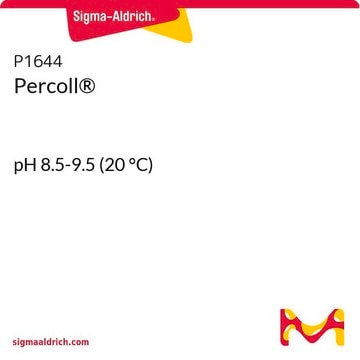2160
Autofluorescence Eliminator Reagent
Autofluorescence Eliminator Reagent for IHC.
Synonym(s):
fluorescence IHC counter stain
Sign Into View Organizational & Contract Pricing
All Photos(5)
About This Item
UNSPSC Code:
41116010
eCl@ss:
42029053
Recommended Products
form
liquid
packaging
pkg of 50 mL
manufacturer/tradename
Chemicon®
technique(s)
immunohistochemistry: suitable
shipped in
ambient
General description
Ready-to-use for application in fluorescence microscopy procedures. With increasing age, the autofluorescent pigment lipofuscin accumulates in the cytoplasm of many cell types, including neurons. The presence of lipofuscin granules can complicate the use of fluorescence microscopy in the central nervous system because of its broad excitation and emission spectra, which overlaps with those of most commonly used fluorophores. The Autofluorescence Eliminator Reagent will reduce or eliminate lipofuscin-like autofluorescence without adversely affecting other fluorescent label in sections of human, monkey or rat neural tissue as well as other tissues.
Application
Fluorescence immunohistochemistry counterstain.
PROTOCOL:
1.After immunofluorescence histochemistry, the sections are immersed in PBS for 5 min.·
2.Sections are immersed in 70% ethanol for 5 min.·
3.Sections are immersed in Autofluorescence Eliminator Reagent for 5 min.
4.Sections are immersed in three changes of 70% ethanol for 1 min. each time.·
5.Sections are mounted using an antifading solution (e.g. DABCO, non-xylene-based).
Note: Reagent will block all fluorescence if incubation is too long; length of incubation time and number of 70% ethanol washes can be altered and optimized for various tissues and fluorescent antibody probes. In some instances the reagent can be applied prior to immunofluorescence, however in most cases better results are obtained when used as we direct above (use after immunofluorescence procedures are completed).
Optimal time of incubation with the Autofluorescence Eliminator Reagent should be determined by the end user for each sample.
Absorption maximum: 595-605
PROTOCOL:
1.After immunofluorescence histochemistry, the sections are immersed in PBS for 5 min.·
2.Sections are immersed in 70% ethanol for 5 min.·
3.Sections are immersed in Autofluorescence Eliminator Reagent for 5 min.
4.Sections are immersed in three changes of 70% ethanol for 1 min. each time.·
5.Sections are mounted using an antifading solution (e.g. DABCO, non-xylene-based).
Note: Reagent will block all fluorescence if incubation is too long; length of incubation time and number of 70% ethanol washes can be altered and optimized for various tissues and fluorescent antibody probes. In some instances the reagent can be applied prior to immunofluorescence, however in most cases better results are obtained when used as we direct above (use after immunofluorescence procedures are completed).
Optimal time of incubation with the Autofluorescence Eliminator Reagent should be determined by the end user for each sample.
Absorption maximum: 595-605
Physical form
Liquid in 70% ethanol containing no preservatives. Store at room temperature in the dark.
Storage and Stability
When stored at room temperature, this reagent is stable up to the expiration date printed on the label. Do not freeze or expose to elevated temperatures.
Legal Information
CHEMICON is a registered trademark of Merck KGaA, Darmstadt, Germany
Disclaimer
Unless otherwise stated in our catalog or other company documentation accompanying the product(s), our products are intended for research use only and are not to be used for any other purpose, which includes but is not limited to, unauthorized commercial uses, in vitro diagnostic uses, ex vivo or in vivo therapeutic uses or any type of consumption or application to humans or animals.
Signal Word
Danger
Hazard Statements
Precautionary Statements
Hazard Classifications
Eye Irrit. 2 - Flam. Liq. 2 - Muta. 2 - STOT SE 2
Target Organs
Eyes,Central nervous system
Storage Class Code
3 - Flammable liquids
WGK
WGK 2
Flash Point(F)
60.8 - 68.0 °F
Flash Point(C)
16 - 20 °C
Certificates of Analysis (COA)
Search for Certificates of Analysis (COA) by entering the products Lot/Batch Number. Lot and Batch Numbers can be found on a product’s label following the words ‘Lot’ or ‘Batch’.
Already Own This Product?
Find documentation for the products that you have recently purchased in the Document Library.
Maritza Oñate et al.
Cell death and differentiation, 27(4), 1169-1185 (2019-10-09)
Parkinson's disease (PD) is the second most common neurodegenerative condition, characterized by motor impairment due to the progressive degeneration of dopaminergic neurons in the substantia nigra and depletion of dopamine release in the striatum. Accumulating evidence suggest that degeneration of
Jenna G Kelly et al.
Brain structure & function, 225(3), 1135-1152 (2020-04-09)
The Kv3.1b potassium channel subunit, which facilitates the fast-spiking phenotype characteristic of parvalbumin (PV)-expressing inhibitory interneurons, is also expressed by subpopulations of excitatory neurons in macaque cortex. We have previously shown that V1 neurons expressing Kv3.1b but not PV or
Our team of scientists has experience in all areas of research including Life Science, Material Science, Chemical Synthesis, Chromatography, Analytical and many others.
Contact Technical Service









